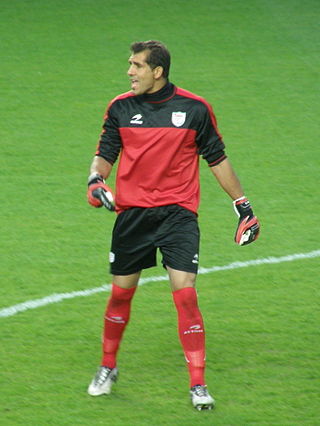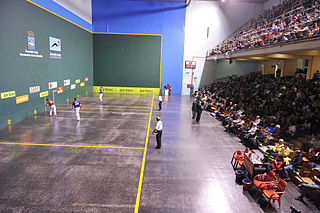
Jai alai is a Basque sport involving bouncing a ball off a walled-in space by accelerating it to high speeds with a hand-held wicker, commonly referred to as a cesta. It is a variation of Basque pelota. The term jai alai, coined by Serafin Baroja in 1875, is also often loosely applied to the fronton where matches take place. The game, whose name means "merry festival" in Basque, is called zesta-punta in the Basque Country. The sport is played worldwide, but especially in Spain, France, the U.S. state of Florida, and in various Latin American countries.

Basque pelota is the name for a variety of court sports played with a ball using one's hand, a racket, a wooden bat or a basket, against a wall or, more traditionally, with two teams face to face separated by a line on the ground or a net. The roots of this class of games can be traced to the Greek and other ancient cultures.

Club Atlético Osasuna, or simply Osasuna, is a Spanish professional football club in Pamplona, Navarre. Founded on 24 October 1920, the club currently plays in La Liga, holding home games at the 23,516-capacity El Sadar Stadium. The team's regular home kit is a red shirt with navy blue shorts. Osasuna is one of four professional La Liga clubs to be owned by its members with an elected president.

The Public University of Navarre, also known by its acronym UPNA or NUP, is a public university created in 1987 by the government of the Spanish autonomous region of Navarre. It has three campuses, located in Pamplona and Tudela. Its activity began in 1989.

Eibar is a city and municipality within the province of Gipuzkoa, in the Autonomous Community of Euskadi. It is the capital of the eskualde / comarca of Debabarrena.

Francisco "Patxi" Puñal Martínez is a Spanish retired professional footballer who played as a defensive midfielder.
Julián Retegui Barbería, also known as Retegi II is an ex-player of Basque pelota. He is also called "El mago de Eratsun", since he is considered one of the best Basque pelota players of all time. He played as a foreplayer.

Gorka Iraizoz Moreno is a Spanish former footballer who played as a goalkeeper, currently manager of Gernika Club.

Atano III is a Basque pelota short fronton located at the Anoeta Sports Complex in San Sebastián, Basque Autonomous Community, Spain.

Ogueta is a short Basque pelota fronton located in Vitoria, in Álava Province, Basque Country, Spain.

Augusto Ibáñez Sacristán is a Basque pelota forward player. Champion of the Doubles Hand-pelota tournaments of 1994, 2000, 2004 and 2012.

The Astelena fronton, nicknamed Cathedral of Basque Hand-pelota, is a fronton located in Eibar, Gipuzkoa, Basque Autonomous Community, Spain.

The International Federation of Basque Pelota is the worldwide governing body for Basque pelota, recognized by the International Olympic Committee. It sets the regulations for international competition and organizes the competitions.
The Deportivo fronton is a Basque pelota fronton, used mainly in the modalities of hand-pelota, short bat, long bat, pala and paleta. It is located in Bilbao and owned by the local municipality. The 52-metre-long facility closed to the public in 2011, with events in the city moving to the Bizkaia fronton in the Miribilla district.

A fronton is a two-walled or single-walled court used as a playing area for Basque pelota.

The Beti Jai fronton is a sport venue located in Madrid, Spain.
The Basque Pelota World Championships is a quadrennial tournament first organized in 1952 by the International Federation of Basque Pelota. The modern championships crown the best amateur players in fifteen different playing categories.
The term Basque derbies refers to the various local derbies between the football teams based in the Basque Country, Spain. This can also include the province of Navarre outside of the autonomous community. It specifically refers to individual matches between the teams, but can also be used to describe the general ongoing rivalry between the clubs and fans.

There is an abandoned Jai alai court in the back of the Hermanos Ameijeiras Hospital, the site of the old Casa de Beneficencia, on Calles Concordia and Lucenas near Calle Belascoain, an area that had been considered in the early part of the city as a place to locate the helpless and the unwanted, it was the edge of the city and the countryside known as the "basurero"; the spectator stands were parallel to Calle Concordia, the front wall of the court faced Calle Lucenas, east in the direction towards Old Havana. The original building has been annexed by five stories of residential concrete construction on the north side along Calle Virtudes. The Havana Jai alai fronton was known as "the palace of screams".
The Basque Pelota World Cup is a set of four quadrennial tournaments organized by the International Federation of Basque Pelota on each of the disciplines of Basque Pelota: Trinquete, Fronton 30m, Fronton 36m and Fronton 54m. The FIPV organizes this tournaments on the years where the World Championships is not played.


















